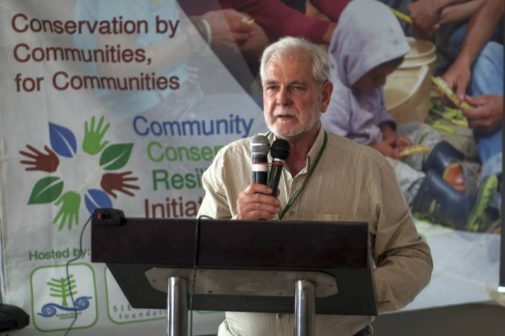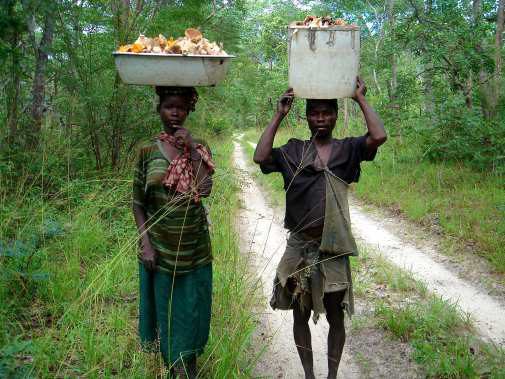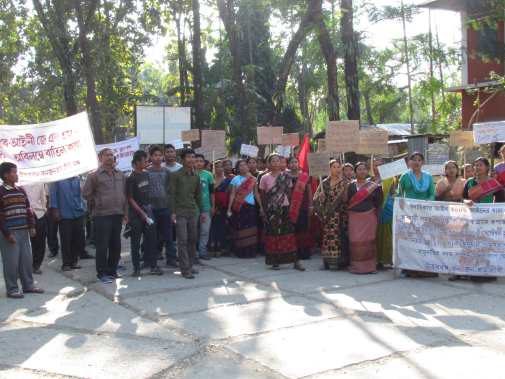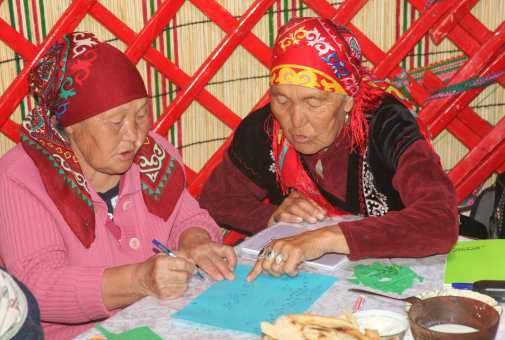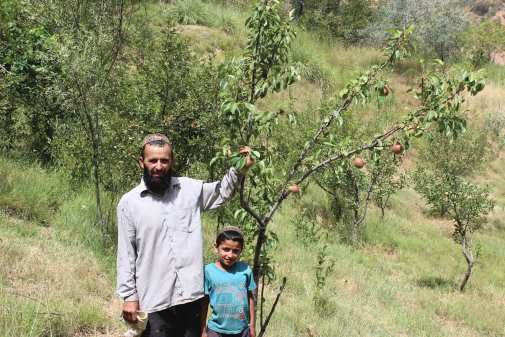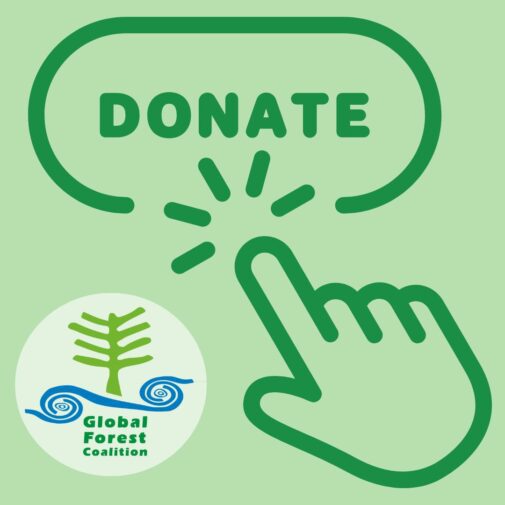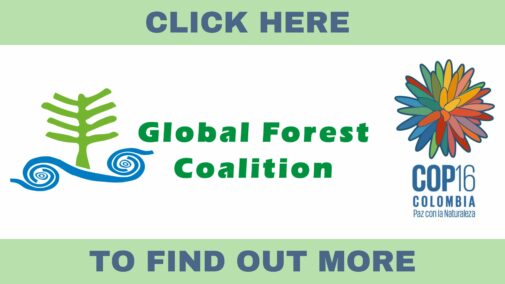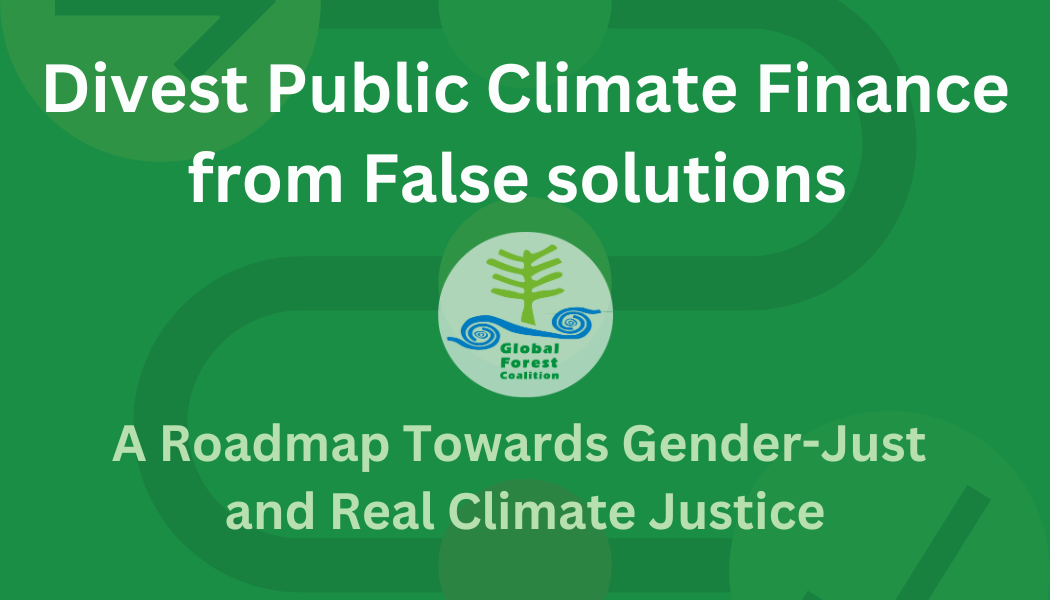Forest Cover 53 – Leaving no one behind: Community rights and biodiversity conservation
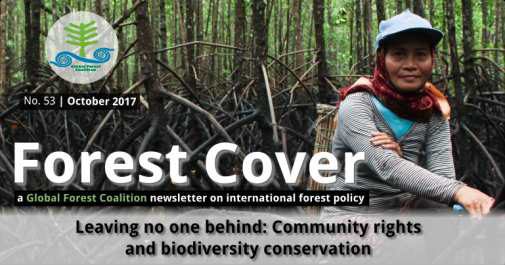
Welcome to Forest Cover No. 53, the Global Forest Coalition newsletter that provides a space for Southern and Northern environmental justice activists to present their views on international forest-related policies.
In this 53rd edition of Forest Cover, published in the run-up to the Convention on Biodiversity’s December discussions on biodiversity conservation and the Sustainable Development Goals, we focus on why it is critical that no one is left behind, which has been chosen as Agenda 2030’s central theme. When it comes to intergovernmental and national efforts to conserve biodiversity and related sustainable development goals, little attention has so far been paid to the valuable contributions made by Indigenous Peoples and local communities, especially women. After all, most degraded areas are located outside their territories. In this issue, we look to Indigenous Peoples and communities around the world—including in Ghana, Kenya, India, Malaysia, Nepal and Tanzania—and their wealth of knowledge and experience about how to conserve the world’s natural riches and use them sustainably. These examples show that recognising their rights to access and use biodiversity is fundamental to achieving the objectives of related policy instruments such as the Convention on Biological Diversity (CBD), the UN Framework Convention on Climate Change (UNFCCC) and the Sustainable Development Goals (SDGs). Fostering Indigenous Peoples’ and local communities’ rights and resilience are fundamental to successful biodiversity conservation.
You can download the print version or read the articles individually below. To subscribe to the newsletter, please write to gfc@globalforestcoalition.org.
Download the print version (web quality) or (low resolution PDF)
Forest Cover 53 is also available in Russian (web quality) or (low resolution)
26 October 2017 – It is with much sadness and regret that we learned of the passing of Wally Menne, a ferocious defender of our environment, and the inspiring founder of one of our most appreciated member groups, the Timberwatch Coalition. We have lost a beacon in the struggle against monoculture tree plantations, environmental degradation and other symptoms of human greed. The GFC mourns his departure, but it is proud to have shared the same cause with such a great human being. Our hearts are with his wife, Rose, and his sons, and with all who loved him.
Contents
1. Community conservation in Nepal contributes to meeting Aichi Biodiversity Targets and Sustainable Development Goals
2. How to assess the contributions of Indigenous Peoples and local communities to the CBD and its Strategic Plan? Let’s start by asking them
3. Ensuring community conservation and a local perspective in the Global Biodiversity Outlook
4. Forest communities’ struggle for traditional and customary use of forests in India
5. About mice, elephants, and the governance of biodiversity mainstreaming
Community conservation in Nepal contributes to meeting Aichi Biodiversity Targets and Sustainable Development Goals
By Dil Raj Khanal, FECOFUN Policy Adviser, Mrinalini Rai, GFC Indigenous Peoples and Gender Advisor & Anila Onta, FECOFUN Gender Facilitator
Over the past three decades Nepal has established itself as a pioneering country for securing community forestry rights through legal and policy measures. In Nepal, more than 20,000 community forestry groups currently manage approximately 40 per cent of the country’s forests. [1]
Community forestry by local groups, along with the practice of traditional knowledge and customary sustainable natural resource management, is an effective form of community-led biodiversity conservation. In Nepal, these community conservation groups have been crucial to addressing threats to biodiversity, and to achieving the relevant international targets of the Convention on Biological Diversity (CBD) and the Sustainable Development Goals (SDGs).
Numerous community reports, field observations, case studies, and background documents about government policies, strategies and plans have shown the positive impacts of community conservation initiatives. These initiatives conducted by community conservation groups – community forestry groups, water and wetland management groups, and other community-based natural resource management groups of Indigenous Peoples and local communities – have significantly contributed to achieving Nepal’s national goals and targets on biodiversity conservation, sustainable use and equitable sharing of benefits. [2] Similarly, these community conservation groups have contributed to achieving the majority of the Aichi Biodiversity Targets and various other SDG targets.
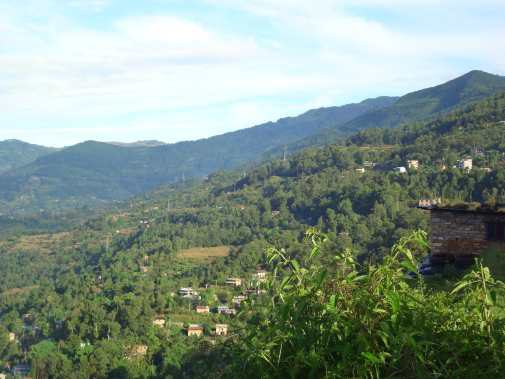
A community forest managed by community forest user groups in Dolakha district of Nepal. Dil Raj Khanal – FECOFUN
The upcoming meetings of the Convention on Biological Diversity that will take place in Montreal in December 2017 (SBSTTA-21 and WG8(j)-10 [3] [4]), will address the implementation of the 2030 Agenda for Sustainable Development with particular emphasis on conservation and sustainable use of biodiversity.
In this context, this article briefly highlights how community conservation groups have contributed to the achievement of global goals on biodiversity and sustainable development.
Contributions to achieving the Aichi Biodiversity Targets

Community members assessing threats to their community conservation efforts during a Community Conservation Resilience Initiative assessment, in Nepal. Dil Raj Khanal/FECOFUN
Working in the context of customary laws as well as government legislation and policy guidance, community conservation groups have been mainstreaming biodiversity conservation in their forest and ecosystem management plans. Different groups have incorporated different provisions and programmes of action into their forest management plans in order to generate awareness about the values of biodiversity, conservation and sustainable use as well as monitoring and reporting on the outcomes and continuing threats to biodiversity at the community level. [5]
The 2015 State of Nepal’s Forests report has shown that community conservation groups have significantly contributed to the reduction of forest degradation and fragmentation after the legal recognition of community forestry rights were formalised in the Forest Act of 1993. This is evidenced by the increasing area of forest land and the decreasing area of shrub land documented in Nepal during the period 1994-2014. [6] Biodiversity conservation and sustainable utilisation is one of the integral elements of community forest management plans. Due to the effective implementation of forest management plans by community conservation groups, alien species have been controlled and/or eradicated within community forests. Community forestry initiatives, particularly in the mid and high hills, have resulted in the protection of socioeconomically and culturally valuable species of wildlife. Areas under community forest management have become important habitats for wildlife.
The community conservation groups have been instrumental in contributing to the achievement of CBD Aichi Targets 14, 15 and 18; one of their main objectives is to restore ecosystem services that contribute to local people’s livelihoods and well-being. Their forest management plans take into account the needs of women, Indigenous Peoples and local communities, and the poor and vulnerable. They also value the importance of traditional knowledge, innovations and practices of indigenous and local communities in their conservation initiatives. Similarly, all community forestry groups have incorporated specific provisions in their forest management plans for ecosystem resilience and to enhance carbon stocks in the community forests.
Nepal has recently ratified the Nagoya Protocol on Access to Genetic Resources and the Fair and Equitable Sharing of Benefits Arising from their Utilization, though national legislation has yet to be developed. Community conservation groups have been demanding that the Nepal government follow a participatory and consultative process to develop legislation on access and benefit sharing.
In 2014, Nepal developed a National Biodiversity Strategy and Action Plan (NBSAP) for the period 2014-2020. This policy document has recognised the important role and contribution of community forestry to achieving the goals, objectives and strategic actions of the NBSAP. The Plan has committed that Indigenous Peoples and local communities will be important community-level actors for the effective implementation of the NBSAP. However, due to limited resources and weak commitment from some government agencies, the implementation status of Nepal’s NBSAP is weak and more emphasis has been given to centralised protected areas rather than community conservation, customary sustainable use and traditional knowledge of Indigenous Peoples and local communities.
Contribution to achieving the SDGs
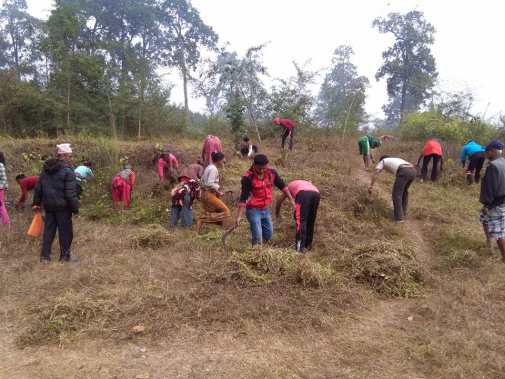
Members of community forest user groups are managing their community forest in Nawalparasi district. Nawalparsi FECOFUN
By mobilising their forest resources and income, community conservation groups have greatly contributed to food security, renewable/alternative energy, community health and education, poverty alleviation and well-being, employment and income generation. These communities have also established their own democratic systems which include at least 33-50% representation of women in their decision-making bodies, and thus contribute to achieving SDG 5 on gender equality and women’s empowerment in Nepal. [7] Community forestry groups have also made important contributions towards achieving SDG 15 on terrestrial ecosystems, including:
• All community forestry groups have their own management plan for the sustainable management of forests and to halt deforestation, forest degradation and biodiversity loss, as well as conserving ecosystems and preventing the spread of invasive alien species.
• Biodiversity is conserved through community conservation initiatives, and the local communities have developed processes for the equitable sharing of benefits arising from forests and biodiversity.
• Community forest groups have established and are mobilising anti-poaching/-trafficking groups, which have been highly successful.
• All types of ecosystems are being sustainably managed by local communities, however the ecosystem services continue to be utilised by the wider public and private sector without providing any compensation to the local communities.
The achievements of the local communities are significant for the realisation of the SDGs in Nepal. Unfortunately, the country lacks a national database or accounting system to document community contributions to achieving the SDGs. Therefore, one of the major gaps in Nepal’s Voluntary National Review is that it has neglected these community contributions, and ignored consultation and data from local communities. Therefore, community conservation groups are strongly demanding that community-level contributions to achieving the Aichi Biodiversity Targets and SDGs are recognised.
Community conservation initiatives will be a strong and sustainable option for realising the 2050 Vision for Biodiversity. However, it is necessary to recognise and support the contributions of Indigenous Peoples and local communities through appropriate laws and policy measures at all levels.
[1] Department of Forests, Community Forestry Division, July 2017, (http://dof.gov.np/publications/community_forestry_bulletin, 2017)
[2] Ministry of Forests and Soil Conservation, 2014. Nepal Biodiversity Strategy and Action Plan 2014-2020. Government of Nepal, Ministry of Forests and Soil Conservation (MoFSC), Kathmandu, Nepal. http://www.mfsc.gov.np/downloadfile/Strategy%20and%20action%20plan_1426572431.pdf
[3] The twenty-first meeting of the Subsidiary Body on Scientific, Technical and Technological Advice (SBSTTA) established under Article 25 of the Convention will be held in Montreal, Canada from 11 to 14 December 2017. https://www.cbd.int/meetings/SBSTTA-21
[4] Ad Hoc Open-ended Inter-Sessional Working Group on Article 8(j) and Related Provisions was established by decision IV/9 of the Conference of the Parties to address the implementation of Article 8(j) and provide the Conference of the Parties with advice relating to the implementation of Article 8(j) and related provisions. The tenth meeting of WG8(j) will be held in Montreal, Canada, from 13-16 December 2017. https://www.cbd.int/meetings/WG8J-10
[5] Government of Nepal, Ministry of Forests and Soil Conservation, 2014. Nepal Fifth National Report to Convention on Biological Diversity, https://www.cbd.int/doc/world/np/np-nr-05-en.pdf
[6] DFRS, 2015. State of Nepal’s Forests. Forest Resource Assessment (FRA) Nepal, Department of Forest Research and Survey (DFRS). Kathmandu, Nepal.
[7] Recognising the Contributions of Women & Local Communities is Required to Achieve the SDGs in Nepal, https://globalforestcoalition.org/wp-content/uploads/2017/09/nepal-shadow-report.pdf
How to assess the contributions of Indigenous Peoples and local communities to the CBD and its Strategic Plan? Let’s start by asking them
By Holly Jonas, CCRI Legal and Advocacy Advisor, Gordon John Thomas, PACOS Trust, Lysandra Chin, PACOS Trust & Beverly Joeman, JOAS
“For us in Sungai Eloi, there are many challenges,” says Mastupang Bin Somoi, 53, a farmer, fisherman and Native Customary Rights defender from Kampung Sungai Eloi. “The area that we have been taking care of for nine generations was taken over by the government for the largest shrimp farm in Malaysia… We are not anti-development, but we want balanced development. We do not want to lose our rights as the Indigenous Peoples who are defending our customary territories.”
Mastupang belongs to the Sungai Tombonuo ethnic group in northern Sabah, Malaysian Borneo. The Sungai Tombonuo depend upon the dense mangroves in their traditional territories for food, fuel wood, medicinal plants and spiritual rituals. They identify and manage areas for conservation and sustainable use based on traditional knowledge and practices. The mangroves are also home to a wide variety of plants and animals, including endangered and endemic species such as proboscis monkeys, and are crucial breeding and spawning grounds for fish and shellfish.

A Sungai Tombonuo woman gathering shells in the mangrove forest in Kampung Sungai Eloi in northern Sabah. PACOS Trust
A government-backed company establishing a large-scale shrimp farm now threatens the survival of Mastupang’s village and several nearby. Since 2012, the company – Sunlight Inno Seafood Company Sdn Bhd – has cleared more than 2,000 acres of mangroves vital to the villagers’ livelihoods and the surrounding environment. At least another 1,000 acres of mangroves are slated for clearance despite protests from the villagers as well as local and international NGOs. An acacia plantation, which was allegedly given the green light despite villagers’ longstanding land rights claims to the same area, places further pressure on the communities and environment alike.
One of the cruel ironies of these so-called ‘development’ projects is that the government is promoting and supporting them under the guise of ‘poverty alleviation’ for rural communities. It is true that the government classifies many villages in this part of Sabah as ‘poor’ and ‘hard core poor’, but this classification is based on limited economic data. It does not consider the deep and multi-faceted relationships between Indigenous Peoples and the territories and areas upon which they depend for their identity, survival, livelihoods and wellbeing – or the devastating impacts of the industrial shrimp farm and acacia plantation on this way of life. It does not consider the informal subsistence and smallscale economies based on fishing, farming and gathering of shellfish and non-timber forest products, which are not quantified in terms of monetary income. It certainly does not consider the many benefits of the Indigenous Peoples’ customary practices for the local forest, mangrove and coastal ecosystems, which in turn provide the basis for clean water, wildlife habitat and fisheries far beyond their village boundaries.

Before the large-scale clearance for the shrimp farm, the mangroves in the Sungai Eloi area were home to a healthy population of endemic proboscis monkeys thanks to the conservation practices of the Sungai Tombonuo people. PACOS Trust
This limited and flawed understanding of ‘poverty’ and ‘development’ does not bode well for Indigenous Peoples and other rural communities as Malaysia strives to achieve developed country status by 2020. Just as most governments’ economic policies fail to capture the true meanings of ‘poverty’ and ‘development’, so too do most governments’ environmental policies fail to recognise the rightsholders who significantly contribute to biodiversity and genuine sustainable development at the local level. Recent advances under the Convention on Biological Diversity (CBD) mandate Parties to the CBD to appropriately recognise and support communities’ contributions to biodiversity, including by recognising territories and areas conserved by Indigenous Peoples and local communities (also known as ICCAs).
Mastupang is one of countless indigenous leaders around the world advocating for legal recognition of their ICCAs. One strategy they are employing is to demonstrate how their ways of life contribute to the conservation and sustainable use of biodiversity across virtually all ecosystems and how they embody a viable alternative to mainstream, topdown narratives of ‘sustainable development’.
Since the 1980s, Partners of Community Organisations in Sabah (PACOS Trust) has been supporting Indigenous Peoples in the state of Sabah to document their customary territories (known locally as wilayah adat), their indigenous worldviews, knowledge and practices, and their self-determined plans and priorities for the future. In recent years, advances in national and state policies and laws have afforded some recognition to community conservation (for example, the tagal system of inland fisheries management), though there remains room for improvement both on paper and in practice.
The Sabah State Government has already protected about 26 per cent of its forests (1.87 million hectares) and has committed to protecting 30 per cent (2.2 million hectares) by 2025. If the government undertakes a genuine process of participatory mapping and spatial planning, it could identify areas that are important for biodiversity that also overlap with wilayah adat and other ICCAs. The work of many communities across the state to document their territories and ways of life, with the support of organisations such as PACOS Trust, would provide a strong basis for such a process and for subsequent recognition and securing of wilayah adat and other ICCAs. This could also provide an important counterbalance to topdown forms of ‘development’ and ‘poverty alleviation’ that actually undermine otherwise sustainable ways of life.
Parties to the CBD will discuss a number of closely related topics when they gather in Montreal in December 2017 for the 21st meeting of the Subsidiary Body on Scientific, Technical and Technological Advice (SBSTTA-21) and the 10th meeting of the Ad Hoc Open-ended Working Group on Article 8(j) and related provisions (WG8(j)-10). Among other things, Parties will consider how to assess Indigenous Peoples’ and local communities’ contributions to the Convention and the 2011-2020 Strategic Plan for Biodiversity (Agenda Item 6, WG8(j)-10).
This topic has been under development for the past several years. In Decision XII/3 on resource mobilisation (2014), the Conference of the Parties recognised the role of Indigenous Peoples’ and local communities’ collective action and non-marketbased approaches (including ICCAs) for mobilising resources to achieve the Convention. In Decision XIII/20 on resource mobilisation (2016), the Conference of the Parties adopted guiding principles on assessing the contribution of Indigenous Peoples and local communities. In December 2017, WG8(j)-10 is expected to develop methodological guidance on identifying, monitoring and assessing the contribution of Indigenous Peoples and local communities to the Strategic Plan, with a view to its adoption at the Conference of the Parties in 2018.
This methodological guidance should draw on good practices and lessons learned from the Community Conservation Resilience Initiative (CCRI), which is coordinated by the Global Forest Coalition and involves national and local partners in 22 countries around the world, including PACOS Trust in Malaysia. Among other things, the CCRI methodology includes core principles such as free, prior and informed consent, participation and representation, and women and gender. Rather than relying on government agencies, academics or large NGOs to assess how Indigenous Peoples and local communities contribute to biodiversity, the methodology places utmost importance on documentation and communication by peoples and communities themselves of their knowledge and practices, threats and challenges, and future visions and plans, including through community protocols. This is a crucial factor in such assessments and can itself support the reempowerment and positioning of Indigenous Peoples and communities as rights-holders rather than mere stakeholders in the CBD.
Accordingly, as CBD Parties develop methodological guidance on identifying, monitoring and assessing the contribution of Indigenous Peoples and local communities to the Strategic Plan, they should first and foremost seek the guidance of peoples and communities themselves. This process provides an additional and important opportunity for Indigenous Peoples and local communities to take ownership over how they are defined and recognised within the context of the CBD. It is incumbent upon CBD Parties and other stakeholders to support them in this effort.
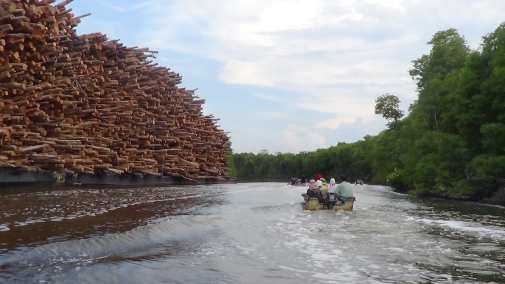
Community members in Sungai Eloi passing acacia logs. Land use rights were allegedly granted to the company that runs the plantation, while communities have been waiting for decades for their land rights claims to be recognised. PACOS Trust
In Kampung Sungai Eloi in northern Sabah, Mastupang reflects on how much the mangrove clearance has affected his community and their vision for the future. “We are the Indigenous People of the area. We should be given the chance to defend our territories.”
Ensuring community conservation and a local perspective in the Global Biodiversity Outlook
By Jeanette Sequeira, GFC Gender Programme Coordinator, the Netherlands, Ken Kinney, The Development Institute, Ghana, Salome Kisenge, Envirocare, Tanzania & Edna Kaptoyo, Indigenous Information Network, Kenya
Community conservation initiatives by Indigenous Peoples and local communities and women are effective, bottom-up, and locally-driven approaches to biodiversity conservation. Their significant promise should be recognised and mainstreamed in national and international biodiversity policy, including in the Convention on Biological Diversity (CBD).
The Global Biodiversity Outlook (GBO), a flagship publication of the CBD, is a periodic report depicting the latest status and trends around biodiversity. It also outlines the key conclusions and analysis on the steps taken or needed to be taken by the global community for the further implementation of the CBD. The preparation of the fifth edition of the GBO (GBO-5) is currently being discussed in the CBD. The GBO-4, published in 2012, paid too little attention to community conservation and the roles of Indigenous Peoples and local communities and women. It is critical that the upcoming report includes community-based information, trends and best practices such as community conservation initiatives by rightsholder groups that are on the frontlines of local biodiversity conservation and sustainable use. The outcomes from Global Forest Coalition’s Community Conservation Resilience Initiative (CCRI) – an initiative that documents and reviews the findings of bottom-up, participatory assessments of the resilience of community conservation initiatives in 22 countries – already demonstrate how important community conservation initiatives are to global biodiversity and the role of Indigenous Peoples and local communities and women in these initiatives. [1]
The 2016 Local Biodiversity Outlooks report by Forest Peoples Programme, the International Indigenous Forum on Biodiversity and the CBD Secretariat provides an excellent overview of community-led and -based contributions to biodiversity conservation in this respect. It is important that such contributions are incorporated into the GBO-5 process and also that Parties support the production of a second edition of the Local Biodiversity Outlooks (as requested in Decision XIII/29).
Findings from the CCRI assessment processes in Kenya, Tanzania and Ghana already show that community-based approaches, such as the Community Resource Management Areas (CREMAs) approach in Ghana, are an effective form of community-based conservation. CREMAs build upon the traditional conservation practices of sacred groves/sites for protecting critical ecosystems. Communities such as the Kpoeta community in Ghana, which is actively engaged in the CREMA programme, use GPS to demarcate and protect the Tsii waterfalls (in the Weto Range of the Upper Guinean Forest of West Africa) and implement buffer-zone planting to protect the water bodies. Other communities have developed small-scale energy production initiatives that use sugar cane, which is already being produced for local gin and presents a community-based alternative to fuel wood from the forest – an initiative which communities want to safeguard from being taken over by large-scale business interests.
In Kenya, a Maasai community around Nyekweri Kimintet Forest in Trans-mara undertook the CCRI and found that its conservation efforts have contributed significantly to conserving this important forest area. However, they also recommended further capacity building through community exchange visits to similar wildlife conservation areas and other practical learning and skillshares of best practices, including with country and national government environmental authorities. Financial support for their community-based, and often female-driven, reforestation initiatives and monitoring of conservation areas as well as advocacy targeting local leadership and environmental authorities of the County Government was also
found to be key. Similarly, in the Tanzania CCRI process, communities in the Siha and Moshi Districts in the Kilimanjaro region have made significant efforts to conserve and enrich the remaining forest areas and protect natural water springs. Community institutions for the protection of local biodiversity and forests, such as the ones already set up in CCRI-participating communities in Kenya and Tanzania, are seen as critical community-based mechanisms that need to be strengthened as they encourage community participation and monitor environmental destruction and community adherence to local village environmental laws.
However, more community awareness around national environmental laws and the effects of climate change is necessary.
The outcomes of these participatory assessment processes in Ghana, Kenya and Tanzania demonstrate the essential role of community conservation, encompassing a range of important practices that ought to be recognised in the GBO-5 as key contributions to global biodiversity conservation.
More specifically, the draft workplan, budget and communication strategy of the GBO-5 should include using data collected on community-based conservation and sustainable use by Indigenous Peoples and local communities and women as key information sources, including these outcomes from the CCRI. While it is expected that information and case studies of Indigenous Peoples and local communities’ collective action will be considered critical elements in the content of the GBO-5, as mentioned in the CBD Secretariat’s Peer Review of the pre-session document, [2] it is critical that their participation in the preparation process is meaningfully facilitated through proper modalities and that these rightsholders are consulted as key expert groups on the oversight and peer review as well as development of the communication strategy.
Last but not least, the participation of women as rightsholders, including indigenous women and grassroots women’s groups, was disappointingly not mentioned in the pre-session document. The GBO-5 will serve as a final report on the implementation of the Strategic Plan for Biodiversity 2011-2020 and as a basis for the post-2020 strategic plan for biodiversity to be reviewed at CBD COP 15. Accordingly, the participation of women, especially indigenous women, in the preparation process, and the recognition of trends, experiences and women-led case studies of biodiversity conservation and how gender has been mainstreamed in practice, cannot be overlooked in the GBO-5. In the CCRI, patriarchy was flagged as an issue in CCRI communities in Kenya and Tanzania where women do not play a strong enough role in decision-making even though their role in biodiversity conservation, as holders and transmitters of traditional knowledge, is significant. The communities recommended that advocacy is needed on women’s land ownership and their increased participation in decision-making.
Moreover, the role of women in conservation should be strengthened through the creation of women’s networks for biodiversity conservation advocacy at the local and country levels, linked to national-level advocacy networks. It is gender-responsive, community-driven solutions like these that need to be highlighted in the GBO-5. The GBO-5 will coincide with the UN Decade on Biodiversity, and therefore is being positioned as a major communication tool; such a report that does not address gender mainstreaming in biodiversity or that excluded the involvement of women, especially indigenous women, as experts would incompletely and inadequately demonstrate the real status of biodiversity on the ground.
[1] See CCRI global overview report https://globalforestcoalition.org/wp-content/uploads/2015/11/CCRI-Report-1.0.pdf
[2] https://www.cbd.int/sbstta/sbstta-21-wg8j-10/GBO5-ProductionPlan-draft-for%20SBSTTA-review.pdf
Forest communities’ struggle for traditional and customary use of forests in India
By Souparna Lahiri, Global Forest Coalition, India
An estimated 147 million villagers in India live in or around forests, and another 275 million villagers depend heavily on forests as a source of livelihood. Livelihood security for forest dependent communities is critically linked to their rights, access to, and control over forest resources. Since the British colonial administration promulgated the Indian Forest Act in 1865, Indian forests came under State control and restricted the access and rights of forest dependent communities. The independent Indian Government formally admitted to this historic blunder on December 2006 at the Indian Parliament.
It is to the credit of the forest communities that even after 150 years of siege and deprivation of their rights and access, the Indian forests are still thriving at 67 million ha (23.41% of the country’s geographical area). With an annual deforestation rate of around 35,000 ha – mainly due to industrial and development projects – it is due to forest communities’ traditional ethos and customs, and their symbiotic relationship with nature, that Indian forests are still surviving.
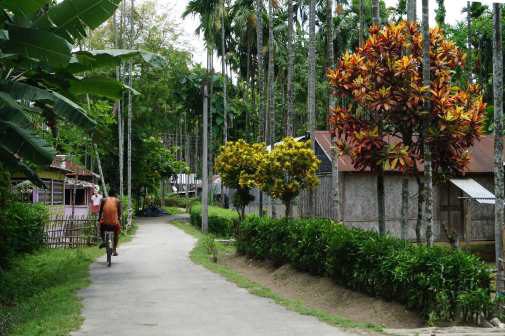
The traditional and customary practices of forest communities have sustained wildlife and biodiversity. Souparna Lahiri/GFC
India’s annual State of Forest Reports indicate that in all of the tribal districts, the current levels of forest cover (over 33%) are significantly higher than the national average of 21%. The available statistical data shows that it is in fact the traditional and customary practices of forest communities that have sustained the Indian forests, wildlife and biodiversity. This despite living in abject poverty, being periodically evicted from their homelands and having their crops and homes burnt and destroyed. Most affected are the women who traditionally venture into the forests for food and fuel wood and who participate in agricultural activities in large numbers.
Recognition of Forest Rights
A long history of struggle by India’s forest dwelling communities – from rebellions to take back homelands usurped by the colonial empire in the 19th century, to a radical movement emerging in the 1990s – culminated in the Indian Parliament being forced to enact the Scheduled Tribes and Other Traditional Forest Dwellers (Recognition of Forest Rights) Act in December 2006. Known as the Forest Rights Act (FRA), this landmark legislation restored and recognised the traditional rights of forest communities that were snatched away in the consolidation of State forests during the colonial period as well as in independent India. [1]
This Act addresses the longstanding insecurity of tenurial and access rights of forest dwelling Scheduled Tribes and other traditional forest dwellers. The FRA ensures that both an individual’s right to agricultural and homestead lands, that are accorded jointly to a woman and her spouse, as well as community rights over forests are recognised, recorded and vested. The recognised rights of the forest dwelling communities [2] include the responsibilities and authority for sustainable use, conservation of biodiversity and maintenance of ecological balance. The Act strengthens the conservation regime of the forests while ensuring livelihood and food security of the forest dwelling groups. The Gram Sabha (or Village Council) is empowered with governance rights to manage, protect and conserve its own forests in a sustainable manner.
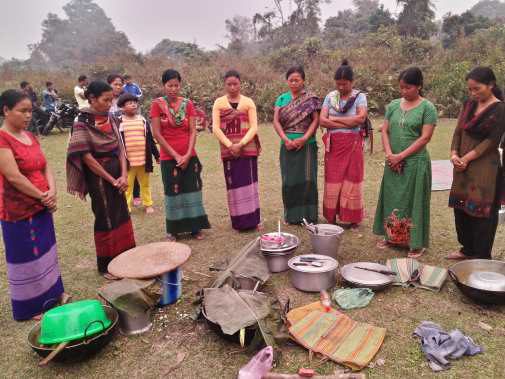
The recognised rights of forest dwelling communities include responsibility for maintaining ecological balance. Souparna Lahiri/GFC
Traditional knowledge is also recognised in the FRA. It makes way for forest communities’ right of access to biodiversity and communities’ right to intellectual property and traditional knowledge related to biodiversity and cultural diversity.
The FRA, therefore, recognises and respects Articles 8(j) and 10(c) of the Convention on Biological Diversity (CBD) and the free, prior and informed consent (FPIC) provisions of the UN Declaration on the Rights of Indigenous Peoples (UNDRIP). It is also a step in the right direction in terms of achieving the CBD’s Aichi Biodiversity Targets.
Changing dynamics, challenges and fall-out from the Forests Rights Act
While the FRA, from the beginning, was opposed by a section of foresters in the Ministry of Environment and Forests (MoEF) and some big conservation organisations, the dynamics within Indian forests were set for a change. In those areas where forest communities were well organised and the social movement was strong, the selfinitiated declaration of formation of Gram Sabhas and demarcation of their community forests proceeded quickly. These communities were able to use the legislation to their advantage and jump into action quickly.
However, after ten years the gap between initial high hopes and poor implementation of FRA is quite stark. Less than 30 per cent of the claims filed have been recorded, and the recording of community forest rights (CFR) has been minimal. Awareness campaigns on the legislation and the claims process amongst the forest communities has been poor, especially in remote areas. The rules and regulations of the Forest Department and draconian forest laws are still prevalent. This is most notable within the National Parks and Tiger Reserves where the Forest Department is refusing to settle rights—in complete violation of the FRA. The National Tiger Conservation Authority has recently issued a memo directing officials not to recognise and settle any rights in tiger reserves, a move which is a violation of Section 4 of the FRA.
However, the forest-dwelling communities have moved forward with their struggles to realise the self-rule of the Gram Sabha and the right to control and govern community forest resources. In North Bengal, along the foothills of the eastern Himalayas, a number of Tongya forest villages selfdeclared their Gram Sabhas and forbade any activities of the Forest Department without their consent. These villages stopped the felling of trees, timber logging, and plantations within their declared community forests. The villages in the Tadoba-Andhari National Park and Tiger Reserve mapped their forest resources and filed claims for CFR. Similarly, many villages in Chhattisgarh have initiated resource mapping on their own and claimed CFRs.
In the Menda Lekha forest area of Maharashtra, around 400 villages got CFR titles and framed their own rules regarding the harvesting of non-timber forest produce, minor forest produce and bamboo. Most of the families residing in these villages have actually surrendered their individual land titles to the Gram Sabha to be part of the collective. The communities have also made attempts at forest restoration with the help of the National Employment Guarantee Scheme, but have not received any further support from the government or the Forest Department.
In the Baiga Chak forest area of Dindori in Madhya Pradesh, the Baigas – the most vulnerable tribal forest dependent communities – stopped the Forest Department from taking over their land for plantations, claimed their habitat rights and forced the district administration to record their rights. In Odisha, there are several districts where the forest communities have formed their Gram Sabhas, claimed their CFRs and framed their own rules for sustainable use of forest resources. Women are at the forefront of most of these struggles, and are participating in large numbers in the meetings of the Gram Sabha. Woman have been taking a lead role in mapping of forest resources, awareness generation amongst forest communities and negotiating with the relevant authorities for claims over CFR.
Across India, large hydro, industrial, mining and other development projects have been stalled as the planned diversion of huge tracts of forests could not be completed as the Gram Sabhas refused to give consent. The Government is trying to dilute the FRA provisions and powers of the Gram Sabha, thereby undermining the free, prior and informed consent of the communities through office memos and circulars. The Ministry of Environment, Forest and Climate Change, at the direction of the Prime Minister’s Office, has already exempted Gram Sabha consent for clearance of certain linear projects such as highways and roadways.
The controversy arising out of the forest clearance for bauxite mining in the Niyamgiri Hills of Odisha by UK-based Vedanta Company is an example of the tension and dynamics emerging between state governments and the forest communities in India today. Subsequent to the Supreme Court of India directing the state government to implement provisions of the FRA and allow the Gram Sabhas of the Dongria Kondh tribe to exercise their rights, the Dongria Kondhs were brave enough to withstand the might of Vedanta and the state government, and refused to give consent to forest diversion for bauxite mining.
India’s forest communities, social movements and community-based organisations are continuing their struggle to realise their rights as set out in the FRA. These are consistent with various international treaties and conventions. For example, nonimplementation of CFR is a violation of Articles 8(j) and 10(c) of the CBD. Violating and diluting FRA provisions related to FPIC leads to an undermining of the UN Declaration on the Rights of Indigenous Peoples. These violations need to be taken up at appropriate levels in appropriate international fora. The right of India’s millions of forest people, and the right of all Indians to thriving forests, demands it!
[1] “Historical injustice to the forest dwelling Scheduled Tribes and other traditional forest dwellers who are integral to the very survival and sustainability of the forest ecosystem”- Preamble of the Scheduled Tribes and Other Traditional Forest Dwellers (Recognition of Forest Rights) Act, Para 3
[2] Called Scheduled Tribes in the Indian constitution
About mice, elephants, and the governance of biodiversity mainstreaming
By Simone Lovera, Global Forest Coalition, Paraguay
There is an old story about a group of mice and a group of elephants playing a soccer match. In the enthusiasm of the game one of the elephants accidentally runs over one of the mice, and stamps him into the ground. When he realises what he did, the elephant frantically apologises, upon which the mouse responds “Oh, don’t bother about it, it could have happened to me as well”. This anecdote is good to keep in mind when we talk about the governance of biodiversity mainstreaming mainstreaming in the upcoming 21st meeting of the Subsidiary Body on Scientific, Technical and Technological Advice (SBSTTA-21) of the Convention on Biological Diversity (CBD).
There is broad consensus that mainstreaming biodiversity into productive sectors – like forestry, agriculture, and even tourism – is essential if we want to reach the internationally agreed target of halting global biodiversity loss by 2020. It was decided at the latest Conference of the Parties of the CBD that big industries operating in these sectors – such as logging companies, soy producers, hotel chains, etc. – should engage with ‘multi-stakeholder governance structures’ to determine how biodiversity can be mainstreamed into their operations. The term ‘multi-stakeholder’ governance structure implies that all relevant actors will be involved, from the large and powerful (transnational corporations and governments) to the small and politically and economically marginalised (Indigenous Peoples, local communities and women).
The latter actors are disproportionately impacted by biodiversity loss, and thus are assumed to be key beneficiaries of sustainable development policies. Indigenous Peoples, local communities and women have clearly defined rights under international law as rightsholder groups, so involving them in governance structures is a logical follow-up to the rights-based transformative approach that is at the heart of the UN Agenda 2030 for Sustainable Development.
Yet, one should wonder whether involving these very different actors in a single governance structure isn’t the same as having elephants and mice competing against each other on the same soccer field. After all, a large corporation or government agency has little to fear from a small indigenous community or women’s group, while communities on the ground risk losing their entire livelihood, and sometimes even their lives, if corporations are allowed to destroy forests, use deadly agrochemicals or violently replace communities to build new tourist resorts. Moreover, the interests of large corporations are primarily commercial. As capitalism requires continued growth of capital, corporations are simply not in a position to promote policy solutions that limit their economic expansion or negatively impact on their short-term or long-term commercial interests. In practice, corporations will often be willing to accept qualitative measures that improve their production, but are incapable of accepting quantitative policy measures that would limit their growth.
Yet it is precisely these quantitative policy measures that are desperately needed to protect biodiversity on a planet with clearly defined natural boundaries.
For example, the aviation industry is by far the most rapidly growing source of greenhouse gas emissions – emissions increased 87 per cent between 1990 and 2014 [1] – driven largely by the dramatic growth of the global tourism industry. But instead of setting limits to growth to mitigate emissions, the International Civil Aviation Organization (ICAO, a UN specialised agency) has proposed a range of false solutions like carbon offsets and biofuel use. At a recent ICAO conference, targets of up to 285 million tons of biofuels by 2050 were proposed, [2] which would require that global biofuel production for transport – already a major source of deforestation and biodiversity destruction – would be more than tripled. Sadly, the Ministerial Declaration of the latest CBD Conference of the Parties – hosted by the city of Cancun in Mexico, one of the world’s most (in)famous tourist resorts – does not even mention aviation-related emissions growth.
The UN Framework Convention on Climate Change itself has recently started a discussion about the need to address possible conflicts of interests in its governance structures, and the Parties to the CBD should follow suit and start seriously addressing this issue too. It will be important for the CBD to approach the concept of ‘conflict of interest’ in a rational manner. Too often, the term ‘conflict of interest’ is seen as accusatory, if not inflammatory. But it is only rational to assume actors have certain economic, social, cultural or moral interests in certain environmental policy options, and thus certain conflicts of interest may arise. The existence of such conflicts of interest is not necessarily malevolent. It is the lack of transparency about – or worse, the denial of – conflicts of interest that can trigger malevolent behavior.
If the status quo is not challenged, power imbalances in CBD governance structures will lead to the interests of the elephants overriding the interests of the mice. It is important to not only address potential conflicts of interest, but also to ensure that rightsholder groups are clearly distinguished from actors that merely have a commercial stake in biodiversity policy.
As the process of developing the next Strategic Plan of the CBD begins in the upcoming intersessional meetings, rightsholder groups like Indigenous Peoples, local communities and women should receive a special status in these crucial negotiations. They should be able to participate fully and effectively through their own representative constituency structures, and their inputs to the process should be clearly distinguished from the inputs of stakeholders that merely have a commercial stake in biodiversity.
[1] http://unfccc.int/resource/docs/2016/sbi/eng/19.pdf
[2] icao.int/Meetings/CAAF2/Documents/CAAF.2.WP.013.4.en.pdf
Editorial Team: Holly Jonas, Simone Lovera and Mrinalini Rai
Editors: Michael Braverman-Scult, Ashlesha Khadse, Ronnie Hall and Isis Alvarez
Layout, Graphic Design & Photo Research: Oliver Munnion
Donate to GFC here.
Front & back cover main photo: PACOS Trust
Other front cover photos: Nawalparsi FECOFUN, PACOS Trust and Simone Lovera/GFC
This Forest Cover was made possible through support from various GFC member groups and contributors, including the Christensen Fund and the International Climate Initiative (IKI) of the German Federal Ministry for the Environment, Nature Conservation, Building and Nuclear Safety (BMUB).
The views expressed in this publication are not necessarily the views of our contributors.


